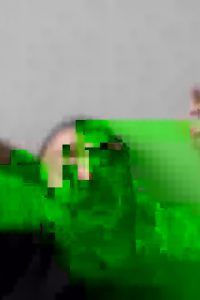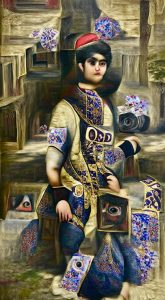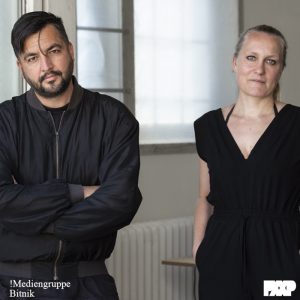Sorry for the long silence, i was a bit dazed by the 2 fantastic days i spent at the School of Architecture of Alicante. Thanks a lot to Paco Mejias, Jose Maria Torres Nadal and a virtual Edgar Gonzalez who have made my stay over there so memorable and fun.
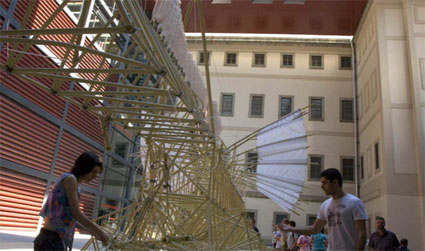 Theo Jansen, Strandbeest
Theo Jansen, Strandbeest
So let’s get back to blogging and to my belated report on Art Futura which took place last week in Barcelona. The director of the festival, Montxo Algora is also the curator, along with Jose Luis de Vicente, of Máquinas&Almas (Machines and Souls), a major exhibition of media art which opened last Summer at the Museo Reina Sofia in Madrid.
Máquinas&Almas (“Souls&Machines”) explores the intersection of art and technology at the beginning of the 21st century through the work of a generation of creators -not only artists- who have defined the limits of the discourse of new media, taking them beyond their speculative beginnings and constructing their strategic and linguistic bases.
I’m not sure the show has received the echo it deserved in the international press but it was certainly remarkable that a museum, famous around the world for its collection of paintings by Salvador Dalí, Pablo Picasso and Salvador Dalí was opening its doors to some 30 works -some of them made especially for the exhibition- created using digital technology.
David Byrne and David Hanson, Song for Julio
The challenge taken by Reina Sofia paid off: Souls and Machines received more than 350,000 visitors, making it the most visited exhibition about art and technology in Spain. I can’t actually imagine another country in Europe where such show could have taken place. Other countries are very open to media art but none of them -and i hope i’m wrong but i doubt it- has more genuine respect and a better taste than Spain for technology-based art. Still, the situation didn’t make
Máquinas&Almas a piece of cake.
Montxo Algora, Vicente Matallana (responsible of the production of the exhibition), Irma Arribas and artist Evru took the stage last Saturday at Art Futura to give us the lowdown of this adventure which took 2 years in the making.
The fairest thing we can experience is the mysterious. It is the fundamental emotion which stands at the cradle of true art and true science.’
This quote by Albert Einstein was the leitmotiv of the exhibition and it was also the cue that guided the work of Irma Arribas whose design of the exhibition tried to generate a relationship based mystery and dialog between the artworks and the visitors.
The artworks were not hermetically separated from each other. Instead, they were divided by semi-transparent curtains, which were both filtering the space and allowing the works to dialog between each other. The whole parcours that lead from one piece to the other was curvy in order to create surprises and a sense of expectation.
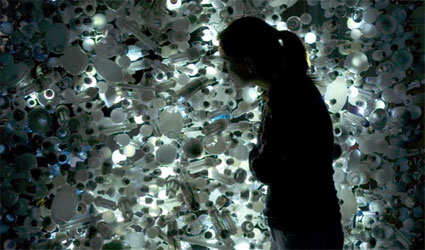 Daniel Canogar, Palimpsesto
Daniel Canogar, Palimpsesto
The most fascinating part of the panel was the presentation of Vicente Matallana whose company LaAgencia was in charge of the production of Máquinas&Almas. LaAgencia has been producing media art events for 10 years and Vicente is the one who best explained why Reina Sofia’s decision to host the exhibition was audacious. The rooms the museum dedicated to M&A were inadequate (too luminous, technologically deficient), the team was remarkably open and cooperative but unprepared to deal with new issues which included:
– how do you deal with the 3600 light bulbs that composed Palimpsesto, the amazing installation of Daniel Canogar?
– what happens to a budget when the price of the material needed for an installation soars unexpectedly, as was the case with Chico McMurtrie‘s Inflatable Architectural Body?
– unlike with traditional exhibitions, the production doesn’t stop once the painting is hung on the wall. The production of a new media art exhibitions lasts until the last day of the show. Works have to be kept in perfect functioning state. Only 70% of the production budget had been spent when the exhibition opened. The remaining 30% were necessary to ensure that the pieces would still be working after constant ‘interaction’ by visitors.
– which is a problem that not only museum have to cope with but also media art festivals which tend to be the only events that exhibit such artworks. A media art festival typically lasts a few days. The exhibition at the Reina Sofia, on the other hand, had to stand several months of almost constant interaction with visitors. The damage done to some of the artworks was tremendous and many pieces had not been conceived to stand the interaction with various people at the same time.
While the presentation of Montxo, Ima and Vicente was certainly instructive and fascinating, a close look at the content of the exhibition can give you further clues about how to set up your own exhibition about media art
Rule number 1: show whatever artworks you like but include something by Rafael Lozano-Hemmer
in your selection. M&A had one of his latest works, Micrófonos (Subescultura 10). Twenty microphones with the archetypal Shure 55 head are mounted on custom-made stands at varying heights and features while integrated circuit are connected to a network of hidden computers. When a visitor speaks into a microphone, the device records his/ her voice and immediately reproduces the voice of a previous participant, like an echo from the past.
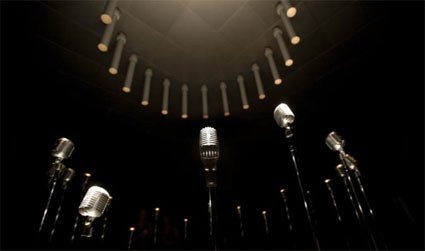 Rafael Lozano-Hemmer, Micrófonos (Subescultura 10)
Rafael Lozano-Hemmer, Micrófonos (Subescultura 10)
Rule number 2, show some respect to the cliche that women don’t understand technology and therefore don’t mingle with media art. And because every rule has its exceptions, do include the work of one (maximum 2) women in your exhibition:
UrbanSpaceStation, an installation that Natalie Jeremijenko developed together with Ángel Borrego.
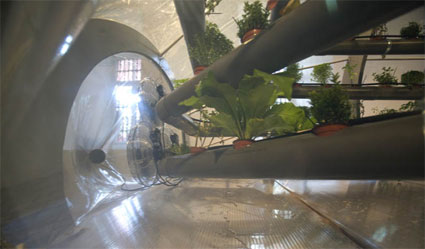 Natalie Jeremijenko and Ángel Borrego, UrbanSpaceStation
Natalie Jeremijenko and Ángel Borrego, UrbanSpaceStation
This prototype of a parasite for urban buildings was designed to sequester the carbon dioxide emissions from buildings and return oxygen-enriched air in exchange. The “greenhouse-laboratory” for rooftops constitutes an intensive urban agriculture facility that reuses building waste streams to produce nutritional resources without burning fossil fuels.
Video:
Rule number 3: demonstrate that media art is mature enough not to take itself too seriously. Let an artist make that point clear for you. Because he defines himself as a (temporarily) retired net artist, Vuk Cosic is the perfect candidate for the role. And please, do add in your press material that Cosic coined the term “net art” in 1995. He’ll be happy to tell the press once again that he never actually coined the term and you’ll be left to wonder whether he’s serious or messing around again.
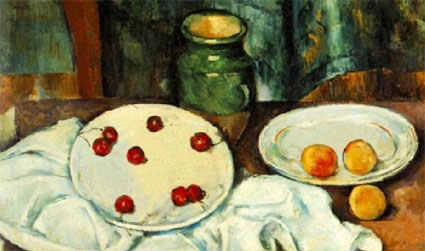 Vuk Cosic, History of Art for the Intelligence Community
Vuk Cosic, History of Art for the Intelligence Community
His History of Art for the Intelligence Community is an homage to the masters of painting. The artist applied the Carnivore Project (a software developed by the Radical Software Group (RSG) and based on recreating data obtained through a FBI programme to intercept information online) to animate canonical artwork – Mantegna, Van Gogh, Malevich, Warhol or Cézanne – in images and subsequently alter them. In Cézanne’s Cherries and Peaches, with Cosic’s programme installed on a computer, the number of fruit pieces changes in real time as the owner sends and receives e-mails.
Rule number 4. Invite a name that critiques of ‘traditional’ contemporary art will have heard of. This will get their attention and ensure that they will visit your show. And if that name is Pierre Huyghe, you’ll get my undying gratitude (not that it should matter much.)
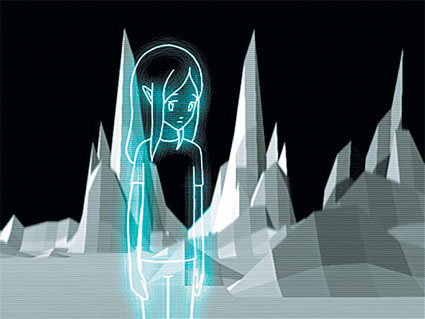 Pierre Huyghe, One Million Kingdoms
Pierre Huyghe, One Million Kingdoms
Together with Philippe Parreno, Huyghe created No Ghost Just a Shell, a multimedia project starring an animated character named AnnLee. In the video One Million Kingdoms, AnnLee moves through a futuristic landscape sketched by a series of graphic curves whose movement is synchronised with the artist’s synthesised voice as it repeats the words spoken by Neil Armstrong on the first moon landing.
Rule number 5. Include some artwork that even the most bored boyfriend dragged in the gallery by the media art buff will like. Make sure that she will appreciate the project as well.
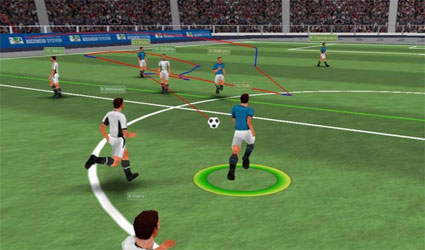 Harun Farocki, Deep Play
Harun Farocki, Deep Play
Harun Farocki‘s Deep Play is a 12-channel video installation that shows different aspects – some of which are generally hidden – of a football game. The filmmaker chose the 2006 World Cup Final between France and Italy to dissect it into synchronised images, which are reproduced on each screen: the artist’s own footage of the game, official FIFA footage, charts of player stats, real-time 2D and 3D animation sequences, and stadium surveillance.
Maybe the best thing is could do is leave you with this video that ADN made of the show:

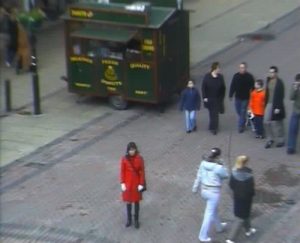
![7 art and tech ideas I discovered at Meta.Morf 2024 – [up]Loaded Bodies 7 art and tech ideas I discovered at Meta.Morf 2024 – [up]Loaded Bodies](https://we-make-money-not-art.com/wp-content/uploads/2024/05/53705969154_73dfdfea6f_c-300x200.jpeg)
